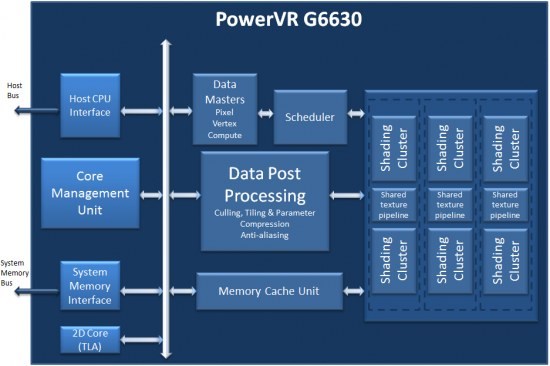
Posted on Monday, November 19 2012 @ 19:52 CET by Thomas De Maesschalck
Imagination Technologies introduces the PowerVR G6630, a new six-cluster mobile graphics processor that promises computing performance of 100 gigaflops to over 1 teraflop! Interestingly, the company claims this new chip is 60x faster than their previous-generation core! Devices based on this new chip are expected to arrive in 2013/2014.
Imagination Technologies, a leading multimedia technologies company, announces the latest six-cluster PowerVR GPU IP core in its ground-breaking PowerVR Series6 family.
The PowerVR G6630 features six shader execution clusters, offering a new high end design point in the Series6 family, which already includes a number of two-cluster and four-cluster IP cores.
PowerVR G6630 is designed to deliver the best possible performance for the widest range of application use cases, within realistic sustainable mobile power and thermal budgets. G6630 delivers advanced power scaling technologies including enabling USC cluster pairs to be shut down depending on the App load, allowing X2, X4 and X6 modes of operation to provide multiple power/performance operating points with the same on-chip GPU.
Says Tony King-Smith, VP marketing, Imagination: “PowerVR Series6 has already set a new benchmark for exceptional performance, ultra-low power GPU cores. With G6630 we continue to demonstrate the inherent scalability of our Series6 architecture, enabling us to satisfy every partner’s power, area, thermal requirements while delivering the best possible user experience across the broadest range of applications, whether graphics or GPU compute intensive.”
Inside the PowerVR Series6 ‘Rogue’ architecture
Based on a scalable number of compute clusters, the PowerVR Series6 architecture is designed to target the requirements of a growing range of demanding markets from mobile to the highest performance embedded graphics including smartphones, tablets, PC, console, automotive and TV. Using these arrays of programmable computing elements PowerVR G6xxx cores deliver class-leading GPU Compute power efficiency while minimising power and bandwidth demands.
PowerVR Series6 GPU cores are designed to offer raw processing performance from 100GFLOPS to more than 1 TFLOP, enabling high-level graphics and GPU Compute performance from mobile through to high-end compute and graphics solutions. Series6 cores are specified to comfortably deliver the raw fill rates required for the latest high resolution smartphones, tablets and TVs, as well as the multiple screen support demanded by the automotive industry.
PowerVR Series6 GPUs deliver full support for all popular and emerging GPU compute APIs including OpenCL 1.x and Renderscript Compute, delivering an optimal balance of performance versus power consumption for mobile and embedded devices. All members of the Series6 family are designed to support all features of the latest graphics APIs including OpenGL ES 3*/2/1.1, OpenGL 3.x/4.x, and full WHQL-compliant DirectX10, with certain family members extending their capabilities to DirectX11.1 functionality.
The PowerVR Series6 family of GPUs delivers a significant portfolio of new technologies and features, including: advanced scalable compute cluster architecture; high efficiency compression technology including lossless image and parameter compression and the widely respected PVRTC2™ texture compression; an enhanced scheduling architecture; dedicated housekeeping processor based on Imagination’s Meta technology; and a new generation Tile Based Deferred Rendering architecture. These features combine to produce a highly latency tolerant architecture that consumes the lowest memory bandwidth in the industry while delivering the optimal performance per mm2 or per mW depending on configuration.

